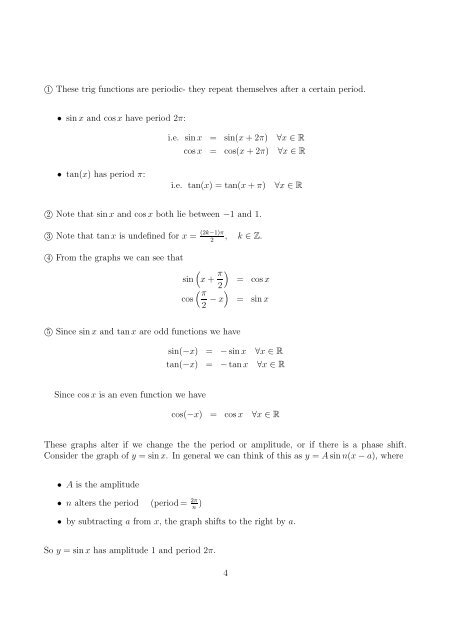Worksheet 4.8 Properties of Trigonometric Functions
Worksheet 4.8 Properties of Trigonometric Functions
Worksheet 4.8 Properties of Trigonometric Functions
You also want an ePaper? Increase the reach of your titles
YUMPU automatically turns print PDFs into web optimized ePapers that Google loves.
1○ These trig functions are periodic- they repeat themselves after a certain period.<br />
• sin x and cos x have period 2π:<br />
• tan(x) has period π:<br />
i.e. sin x = sin(x + 2π) ∀x ∈ R<br />
cos x = cos(x + 2π) ∀x ∈ R<br />
i.e. tan(x) = tan(x + π) ∀x ∈ R<br />
2○ Note that sin x and cos x both lie between −1 and 1.<br />
3○ Note that tan x is undefined for x = (2k−1)π<br />
2 , k ∈ Z.<br />
4○ From the graphs we can see that<br />
<br />
sin x + π<br />
<br />
2<br />
π<br />
<br />
cos − x<br />
2<br />
5○ Since sin x and tan x are odd functions we have<br />
Since cos x is an even function we have<br />
= cos x<br />
= sin x<br />
sin(−x) = − sin x ∀x ∈ R<br />
tan(−x) = − tan x ∀x ∈ R<br />
cos(−x) = cos x ∀x ∈ R<br />
These graphs alter if we change the the period or amplitude, or if there is a phase shift.<br />
Consider the graph <strong>of</strong> y = sin x. In general we can think <strong>of</strong> this as y = A sin n(x − a), where<br />
• A is the amplitude<br />
• n alters the period (period = 2π<br />
n )<br />
• by subtracting a from x, the graph shifts to the right by a.<br />
So y = sin x has amplitude 1 and period 2π.<br />
4
















